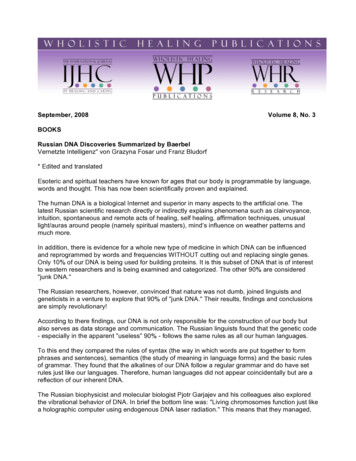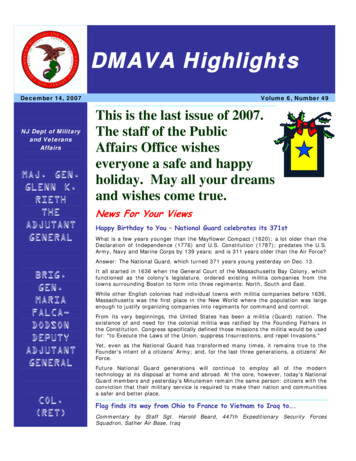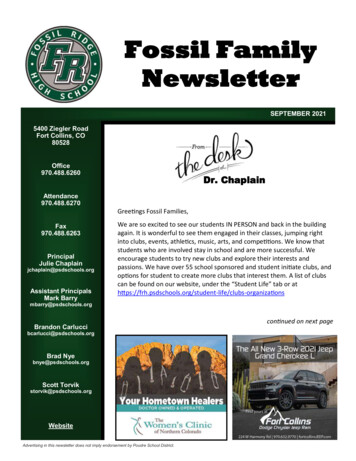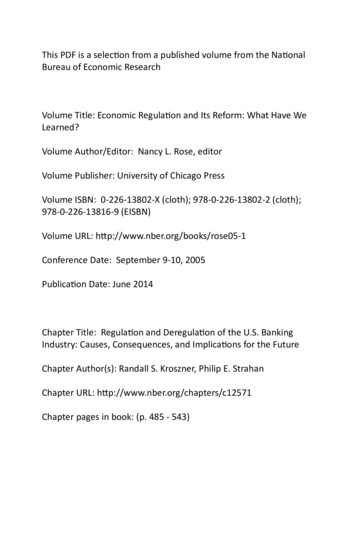
Transcription
September, 2008Volume 8, No. 3BOOKSRussian DNA Discoveries Summarized by BaerbelVernetzte Intelligenz" von Grazyna Fosar und Franz Bludorf* Edited and translatedEsoteric and spiritual teachers have known for ages that our body is programmable by language,words and thought. This has now been scientifically proven and explained.The human DNA is a biological Internet and superior in many aspects to the artificial one. Thelatest Russian scientific research directly or indirectly explains phenomena such as clairvoyance,intuition, spontaneous and remote acts of healing, self healing, affirmation techniques, unusuallight/auras around people (namely spiritual masters), mind’s influence on weather patterns andmuch more.In addition, there is evidence for a whole new type of medicine in which DNA can be influencedand reprogrammed by words and frequencies WITHOUT cutting out and replacing single genes.Only 10% of our DNA is being used for building proteins. It is this subset of DNA that is of interestto western researchers and is being examined and categorized. The other 90% are considered"junk DNA."The Russian researchers, however, convinced that nature was not dumb, joined linguists andgeneticists in a venture to explore that 90% of "junk DNA." Their results, findings and conclusionsare simply revolutionary!According to there findings, our DNA is not only responsible for the construction of our body butalso serves as data storage and communication. The Russian linguists found that the genetic code- especially in the apparent "useless" 90% - follows the same rules as all our human languages.To this end they compared the rules of syntax (the way in which words are put together to formphrases and sentences), semantics (the study of meaning in language forms) and the basic rulesof grammar. They found that the alkalines of our DNA follow a regular grammar and do have setrules just like our languages. Therefore, human languages did not appear coincidentally but are areflection of our inherent DNA.The Russian biophysicist and molecular biologist Pjotr Garjajev and his colleagues also exploredthe vibrational behavior of DNA. In brief the bottom line was: "Living chromosomes function just likea holographic computer using endogenous DNA laser radiation." This means that they managed,
2for example, to modulate certain frequency patterns (sound) onto a laser-like ray which influencedDNA frequency and thus the genetic information itself.Since the basic structure of DNA-alkaline pairs and of language (as explained earlier) is of thesame structure, no DNA decoding is necessary. One can simply use words and sentences of thehuman language! This, too, was experimentally proven!Living DNA substance (in living tissue, not in vitro) will always react to language-modulated laserrays and even to radio waves, if the proper frequencies (sound) are being used. This finally andscientifically explains why affirmations, hypnosis and the like can have such strong effects onhumans and their bodies. It is entirely normal and natural for our DNA to react to language.While western researchers cut single genes from DNA strands and insert them elsewhere, theRussians enthusiastically created devices that influence cellular metabolism through modulatedradio and light frequencies, thus repairing genetic defects.They even captured information patterns of a particular DNA and transmitted it onto another, thusreprogramming cells to another genome. So they successfully transformed, for example, frogembryos to salamander embryos simply by transmitting the DNA information patterns! This way theentire information was transmitted without any of the side effects or disharmonies encounteredwhen cutting out and re-introducing single genes from the DNA.This represents an unbelievable, world-transforming revolution and sensation: by simply applyingvibration (sound frequencies) and language instead of the archaic cutting-out procedure!This experiment points to the immense power of wave genetics, which obviously has a greaterinfluence on the formation of organisms than the biochemical processes of alkaline sequences.Esoteric and spiritual teachers have known for ages that our body is programmable by language,words and thought. This has now been scientifically proven and explained.Of course the frequency has to be correct. And this is why not everybody is equally successful orcan do it with always the same strength. The individual person must work on the inner processesand development in order to establish a conscious communication with the DNA.The Russian researchers work on a method that is not dependent on these factors but willALWAYS work, provided one uses the correct frequency. But the higher developed an individual'sconsciousness is, the less need is there for any type of device: one can achieve these results byoneself. Science will finally stop laughing at such ideas and will confirm and explain the results.And it doesn't end there.The Russian scientists also found out that our DNA can cause disturbing patterns in a vacuum,thus producing magnetized wormholes! Wormholes are the microscopic equivalents of the socalled Einstein-Rosen bridges in the vicinity of black holes (left by burned-out stars).These are tunnel connections between entirely different areas in the universe through whichinformation can be transmitted outside of space and time. The DNA attracts these bits ofinformation and passes them on to our consciousness. This process of hyper-communication(telepathy, channeling) is most effective in a state of relaxation.Stress, worry or a hyperactive intellect prevent successful hyper-communication or the informationwill be totally distorted and useless. In nature, hyper-communication has been successfully applied
3for millions of years. The organized flow of life in insects proves this dramatically. Modern manknows it only on a much more subtle level as "intuition." But we, too, can regain full use of it.As an example from nature, when a queen ant is separated from her colony, the remaining workerants will continue building fervently according to plan. However, if the queen is killed, all work in thecolony stops. No ant will know what to do. Apparently, the queen transmits the "building plans"even if far away - via the group consciousness with her subjects. She can be as far away as shewants, as long as she is alive.In humans, hyper-communication is most often encountered when one suddenly gains access toinformation that is outside one's knowledge base. Such hyper-communication is then experiencedas inspiration or intuition (also in trance channeling). The Italian composer Giuseppe Tartini, forinstance, dreamt one night that a devil sat at his bedside playing the violin. The next morningTartini was able to note down the piece exactly from memory. He called it the Devil's Trill Sonata.For years, a 42-year old male nurse dreamt of a situation in which he was hooked up to a kind ofknowledge CD-ROM. Verifiable knowledge from all imaginable fields was then transmitted to himthat he was able to recall in the morning. There was such a flood of information that it seemed awhole encyclopedia was transmitted at night. The majorities of facts were outside his personalknowledge base and reached technical details of which he knew absolutely nothing. When hypercommunication occurs, one can observe in the DNA, as well as in the human, supernaturalphenomena.The Russian scientists irradiated DNA samples with laser light. On screen, a typical wave patternwas formed. When they removed the DNA sample, the wave pattern did not disappear, itremained. Many controlled experiments showed that the pattern continued to come from theremoved sample, whose energy field apparently remained by itself. This effect is now calledphantom DNA effect. It is surmised that energy from outside of space and time still flows throughthe activated wormholes after the DNA was removed. The side effects encountered most often inhyper-communication in humans are inexplicable electromagnetic fields in the vicinity of thepersons concerned.Electronic devices like CD players and the like can be irritated and cease to function for hours.When the electromagnetic field slowly dissipates, the devices function normally again. Manyhealers and psychics know this effect from their work: the better the atmosphere and energy, themore frustrating it can be for recording devices as they stop functioning at that exact moment.Often by next morning all is back to normal.Perhaps this is reassuring to read for many, as it has nothing to do with them being technicallyinept; it means they are good at hyper-communication.In their book Vernetzte Intelligenz, Grazyna Gosar and Franz Bludorf explain these connectionsprecisely and clearly. The authors also quote sources presuming that in earlier times humanity hadbeen just like the animals: very strongly connected to group consciousness and thereby acted as agroup. In order to develop and experience individuality, however, we humans had to forget hypercommunication almost completely.Now that we are fairly stable in our individual consciousness, we can create a new form of groupconsciousness - namely one in which we attain access to all information via our DNA without beingforced or remotely controlled about what to do with that information. We now know that just as weuse the internet, our DNA can feed proper data into the network, can retrieve data from thenetwork, and can establish contact with other participants in the network. Remote healing,
4telepathy or "remote sensing" about the state of another can thus be explained. Some animalsknow from afar when their owners plan to return home. This can be freshly interpreted andexplained via the concepts of group consciousness and hyper-communication.Any collective consciousness cannot be sensibly used over any period of time without a distinctiveindividuality; otherwise we would revert to a primitive herd instinct that is easily manipulated.Hyper-communication in the new millennium means something quite different.Researchers think that if humans with full individuality would regain group consciousness, theywould have a god-like power to create, alter and shape things on Earth! AND humanity iscollectively moving toward such a group consciousness of the new kind.Fifty percent of children will become a problem as soon as they go to school, since the systemlumps everyone together and demands adjustment. But the individuality of today's children is sostrong that they refuse this adjustment and resist giving up their idiosyncrasies in the most diverseways.At the same time more and more clairvoyant children are born. Something in those children isstriving more towards the group consciousness of the new kind, and it can no longer besuppressed.As a rule, weather for example is rather difficult to influence by a single individual. But it may beinfluenced by group consciousness (nothing new about this to some indigenous tribes). Weather isstrongly influenced by Earth resonance frequencies (Schumann frequencies). But those samefrequencies are also produced in our brains, and when many people synchronize their thinking orwhen individuals (spiritual masters, for instance) focus their thoughts in a laser-like fashion, then itis not at all surprising that they can influence the weather.A modern day civilization which develops group consciousness would have neither environmentalproblems nor scarcity of energy: for if it were to use such mental powers as a unified civilization, itwould have control of the energies of its home planet as a natural consequence.When a great number of people become unified with higher intention as in meditating on peace potentials of violence also dissolve.Apparently, DNA is also an organic superconductor that can work at normal body temperature, asopposed to artificial superconductors which require extremely low temperatures between 200 and140 C to function. In addition, all superconductors are able to store light and thus information. Thisfurther explains how DNA can store information.There is another phenomenon linked to DNA and wormholes. Normally, these super-smallwormholes are highly unstable and are maintained only for the tiniest fractions of a second. Undercertain conditions stable wormholes can organize themselves, which then form distinctive vacuumdomains in which for example, gravity can transform into electricity. Vacuum domains are selfradiant balls of ionized gas that contain considerable amounts of energy. There are regions inRussia where such radiant balls appear very often.Following the ensuing confusion the Russians started massive research programs leading finally tosome of the discoveries mentions above. Many people know vacuum domains as shiny balls in thesky. The attentive look at them in wonder and ask themselves, what they could be.
5I thought once: "Hello up there. If you happen to be a UFO, fly in a triangle." And suddenly, the lightballs moved in a triangle. Or they shot across the sky like ice hockey pucks: they accelerated fromzero to crazy speeds while sliding silently across the sky. One is left gawking and I have, as manyothers, too, thought them to be UFOs. Friendly ones, apparently, as they flew in triangles just toplease me.Now, the Russians found - in the regions where vacuum domains often appear - that sometimes flyas balls of light from the ground upwards into the sky, and that these balls can be guided bythought. Since then it has been found that vacuum domains emit waves of low frequency that arealso produced in our brains and because of this similarity of waves they are able to react to ourthoughts. To run excitedly into one that is on ground level might not be such a great idea, becausethose balls of light can contain immense energies and are capable of mutating our genes.Many spiritual teachers also produce such visible balls or columns of light in deep meditation orduring energy work, which trigger decidedly pleasant feelings and do not cause any harm.Apparently this is also dependent on some inner order, quality and origin of the vacuum domain.There are some spiritual teachers, like the young Englishman Ananda, for example, with whomnothing is seen at first, but when one tries to take a photograph while they sit and speak ormeditate in hyper-communication, one gets only a picture of a white cloud on a chair.In certain Earth healing projects, such light effects also appear on photographs. Simply put, thisphenomena has to do with gravity and anti-gravity forces that are ever more stable forms ofwormholes and displays of hyper-communication with energies from outside our time and spacestructure. Earlier generations that experienced such hyper-communication and visible vacuumdomains were convinced that an angel had appeared before them: and we cannot be too sure towhat forms of consciousness we can get access when using hyper-communication.Not having scientific proof for their actual existence, people having had such experiences do NOTall suffer from hallucinations. We have simply made another giant step towards understanding ourreality. Official science also knows of gravity anomalies on Earth that contribute to the formation ofvacuum domains. Recently gravity anomalies have been found in Rocca di Papa, south of Rome.The full article can be viewed - in English - on the Kontext website below.All information is from the book "Vernetzte Intelligenz" von Grazyna Fosar und Franz Bludorf, ISBN3930243237, summarized and commented by Baerbel. The book is unfortunately only available inGerman so far. You can reach the authors here:Kontext - Forum for Border Science http://www.fosar-bludorf.comJames Surowiecki, The Wisdom of Crowds, New York: Anchor/Random House 2005. 306 pp Notes 20 ppThis is a very important book. James Surowiecki presents a wonderfulspectrum of examples of how collective consciousness is superior toindividual contributions to that consciousness.In the simplest example, Francis Galton, a British scientist, attended acountry fair. He was curious in a weight-guessing contest to see howclose the average of all guesses came in assessing the weight of an oxafter it had been slaughtered and dressed. The meat was the prize forthe closest estimate. He expected that the average of the 787 legiblesubmissions would be considerably off the mark, because many peoplewith no expertise whatsoever were participating in the hopes of winning.
6“Many non-experts competed,” Galton wrote in the scientific journal Nature, “like clerks andothers who have no expert knowledge of horses, but who bet on races, guided bynewspapers, friends, and their own fancies.” The analogy to a democracy, in which people ofradically different abilities and interests each get one vote, had suggested itself to Galtonimmediately. “The average competitor was probably as well fitted for making a just estimateof the dressed weight of the ox as an average voter is of judging the merits of most politicalissues on which he votes,” he wrote. (p. xii)The average of all guesses was 1,197 pounds and the ox weighed 1,198 pounds.Surowiecki notes that many have expressed serious skepticism about the wisdom of groups ofpeople. Notable among these have been Charles Mackay, a Scottish journalist, who wrote aboutthe madness of crowds in 1841; Bernard Baruch, an early 20th century speculator; Henry DavidThoreau; and Friedrich Nietsche. Surowiecki acknowledges that there are situations in whichcrowds demonstrate execrably poor wisdom, as in the crowds who egg on people to jump whenpoised for suicidal leaps to their death.Countering the skeptics and the dictates of simple logic as stated by Galton, Surowiedki, with amarvelous gift of pattern recognition, expands upon his original example, considering the wisdomof crowds in addressing various types of problems. He demonstrates repeatedly, in diversesituations, how the collective wisdom of groups of people outweighs the wisdom of any of theparticipants in the group – even the judgments of the most educated and expert participants inthese groups.A lovely example is that of the US submarine Scorpion, which disappeared in the Atlantic with noknown cause. Although the navy knew the sub’s last reported location, it had no idea what had happenedto the Scorpion, and only the vaguest sense of how far it might have traveled after it had lastmade radio contact. As a result, the area where the navy began searching for the Scorpionwas a circle twenty miles wide and many thousands of feet deep. You could not imagine amore hopeless task. The only possible solution, one might have thought, was to track downthree or four top experts on submarines and ocean currents, ask them where they thoughtthe Scorpion was, and search there. But as Sherry Sontag and Christopher Drew recount intheir book, Blind Man’s Bluff, a naval officer named John Craven had a different plan.First, Craven concocted a series of scenarios – alternative explanations for what might havehappened to the Scorpion. Then he assembled a team of men with a wide range ofknowledge, including mathematicians, submarine specialists, and salvage men. Instead ofasking them to consult with each other to come up with an answer, he asked each of them tooffer his bst guess about how likely each of the scenarios was. To keep things interesting, theguesses were in the form of wagers, with bottles of Chivas Regal as prizes. And so Craven’smen bet on why the submarine ran into trouble, on its speed as it headed to the oceanbottom, on the steepness of its descent, and so forth.Needless to say, no one of these pieces of information could tell Craven where the Scorpionwas. But Craven believed that if he put all the answers together, building a composite pictureof how the Scorpion died, he’d end up with a pretty good idea of where it was. And that’sexactly what he did. He took all the guesses, and used a formula called Bayes’s theorem to
7estimate the Scorpion’s final location. (Bayes’s theorem is a way of calculating how newinformation about an event changes your preexisting expectations of how likely the eventwas.) When he was done, Craven had what was, roughly speaking, the group’s collectiveestimate of where the submarine was.The location that Craven came up with was not a spot that any individual member of thegroup had picked The final estimate was a genuinely collective judgment that the group asa whole had made, as opposed to representing the individual judgment of the smartestpeople in it. it was also a genuinely brilliant judgment. Five months after the Scorpiondisappeared, a navy ship found it. It was 220 yards from where Craven’s group had said itwould be.(pp. xx-xxi)Cognition problemsSurowiedki examines the unusual situation of the TV show, Who wants to be a millionaire?Contestants could walk away with a million dollars if they correctly answered 15 successivemultiple-choice questions of increasing difficulty. Contestants could call upon a trusted outsideadvisor or on the TV audience (who responded by computerized votes). We might guess that logicwould suggest that the smartest person contestants could pick ought to score better than therandom collection of people sitting in a TV studio on a weekday afternoon. Well, guess again. Theexperts answered correctly 65 percent of the time, while the audience was 91 percent on target.Surowiedki reviews many research studies of guesses similar to Galton’s original situation, such asestimating beans in a jar or ranks of items by weight. Invariably, the average of group guesses iscloser to the actual number than the vast majority of individual guesses. In another example,gamblers’ betting odds show that the public is extremely savvy, and those who set the odds arelikewise very astute at guessing outcomes of events.What is even more fascinating is that a diverse group that includes experts and non-experts infields relevant to a problem being addressed will usually do better than a group composed only ofexperts in the relevant field.He then expands to consider votes by public purchases and sales of shares on the stock marketfollowing the space shuttle Challenger disaster of 1986. Within minutes following the disaster, theprices of shares of contractors that could have been involved in causing the disaster dropped:Lockheed (ground support manager); Martin Marietta (manufactured the external fuel tank);Rockwell International (builder of the shuttle and its main engines); and Morton Thiokol (built thebooster rocket). By the end of the day, the price of Thiokol had dropped 12 percent, while the otherprices had each rebounded from 6 percent to 3 percent drops. It took six months to identify whatcaused the disaster (O-rings designed by Thiokol), but the wisdom of the stock market crowd wasright on target on day 1 of the disaster.Detailed investigations (including scrutiny of possible insider trading) turned up no clues to how thepublic immediately identified the culprit. Surowiecki believes that the wisdom of crowds explainsthis unusual finding. He identifies four contributing components to this wisdom: diversity ofinformation and opinions; individual participants’ independence in their contribution to the guesses;decentralization of sources of knowledge; and aggregation of the individual opinions into acollective decision.Coordination problems
8The wisdom of groups of people is challenged when they must coordinate the opinions and actionsof large numbers of people. There are situations in which it is very difficult to sort out how toachieve the maximum benefits from the inputs of individual group participants, as in factories withmany separate steps in production lines. Surowiecki demonstrates that the wisdom of groups ofworkers can often overcome these potential difficulties in successful collaborations.Cooperation problemsTrusting strangers is something we do all the time, without thought, particularly in commerce.Surowiecki discusses how such trust developed as international commerce developed, andpresents various studies on how people will cooperate in market settings.The broader implications of the issues discussed in this book are far-reaching. Surowiecki makes agood case for a trust in democracy as a form of government, if the special interests of lobbyinginfluences can be controlled.What I found of most interest was a hope in the collective wisdom of mankind to deal with thechallenges of global heating.A serious deficiency in this book, however, is a total lack of consideration of intuition and collectiveconsciousness – for which there is a major body of substantiating research. These constitute majorfurther potential strengths in the wisdom of groups of people. A prime example is in the collectiveguesses that led to the location of the Scorpion.Another annoying deficiency of the book is the lack of an index.Book review by Daniel J. Benor, MDIJHC EditorMalcolm Gladwell, The Tipping Point: How Little Things Can Make a Big Difference, NewYork: Little, Brown & Company 2000. 301 pp Notes 12 pp. 14.95This is an important book in today’s world, where global heating (‘warming’ is an unacceptableeuphemism), exhaustion of natural resources, pollution; and the potentials for major wars overdwindling food, water and other necessities of life are threatening the continuation of life as weknow it on our planet. No one knows when we might reach a point of no return, a crucial tippingpoint, in any of these processes – as well as in countless, possibly even unrecognized andunknown other ones.Malcolm Gladwell discusses various elements that contribute to the development of, transitionthrough, and adaptations to the effects of varieties of tipping points. In a very readable andengaging manner, he takes us through the sudden breakthroughs of awareness in individuals thatthen spread rapidly through segments of society, sometimes just locally and sometimes globally.Consider major shifts of consciousness In clothing – such as Hush Puppies, the brushed suede shoes that jumped from sales of30,000 pairs per year in 1994 to 430,000 pairs in 1995: What led this sudden fad to catch on? In health – such as the outbreak of syphilis in Baltimore, where cases jumped by 500 percentbetween 1995-1996: What social changes occurred to cause this many new venereal
9infections? In education – such as “when the number of professionals [in the local community] droppedbelow 5 percent, the problems explode. For black schoolchildren, for example, as thepercentage of high-status workers falls just 2.2 percentage points – from 5.6 percent to 3.4percent – drop-out rates [from schools] more than double. At the same Tipping Point, the ratesof child-bearing for teenaged girls nearly double.” (p. 13) What shifts occur in the communalconsciousness at that point in time in the social flows of existence? In crime – such as the rapid decrease in criminal activity in New York City in the 1990s.Gladwell hypothesizes that there are three rules which help to understand such tipping points:1. The Law of the Few: It only takes a small number of people to spark a shift;2: The Stickiness Factor: Words or concepts that have an impact; and3: The Power of Context: People are more likely to respond in distinct manners within particularcontexts.Considering the importance of shifting consciousness towards more healing ways of relating toeach other and to our planet, these laws suggest that it may be possible to develop the healingmemes (conceptual viruses) that could tip global consciousness towards survival rather thansuicide of humanity and genocide of most other living organisms on our planet.Gladwell continues with further suggestions for how the rules can be deliberately activated increating desired tipping points. Potential contributors to these processes are mavens, who areunusually knowledgeable people with gifts for lateral thinking; connectors, who are people withextensive lists of people who are relevant to given areas of social consciousness and activity; andsalespeople, who are gifted at getting the new concepts across to all and sundry.Gladwell presents another fascinating fact contributing to harmonious communications. People cancomfortably and harmoniously communicate with 150 other people in a working or livingenvironment. Within that number, it is possible to know everyone personally. This facilitates mutualunderstanding and cooperation. Beyond that number, people become anonymous; it is moredifficult to understand and trust their intentions and actions; and it is easy for mistrust anddisharmony to creep in and wreak havoc.I cannot recommend this book highly enough for anyone considering working towards makingpositive changes in our world.Review by Daniel J. Benor, MD, ABHMEditor, IJHCLarry Dossey, The Extra-Ordinary Healing Power of Ordinary Things: Fourteen natural stepsto health and happiness, New York: Harmony/ Random House 2006. 305 ppNotes 32 pp 24.95Larry Dossey is one of my favorite authors. I always look forward to reading anything he haswritten, as there is always information and wisdom with healing in his writings. This book iscertainly no exception.His fourteen chapters consider the topics of optimism, forgetting, novelty, tears, dirt, music, risk,plants, bugs, unhappiness, nothing, voices, mystery and miracles. In each, Dossey considers how
10aspects of each of these elements can enrich our lives. I particularly enjoy Dossey’s gifts of patternrecognition and lateral thinking, which point out fresh awarenesses and understandings of theworld.Here are just a few of the numerous gems you will find in this lovely, informative book:Under Dirt:Throughout history, rituals evolved as a way of acting out and neutralizing the dirt of theshadow [deeply buried aspects of our awareness], thus functioning as a kind of safety valvefor the psyche. These rituals were bawdy, relatively innocuous, and fun. For centuries theChur
BOOKS Russian DNA Discoveries Summarized by Baerbel Vernetzte Intelligenz" von Grazyna Fosar und Franz Bludorf * Edited and translated Esoteric and spiritual teachers have known for ages that our body is programmable by language, words and thought. This has now been scientifically proven and explained.











